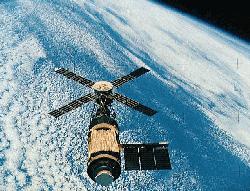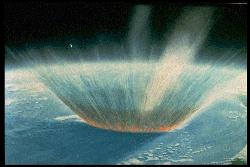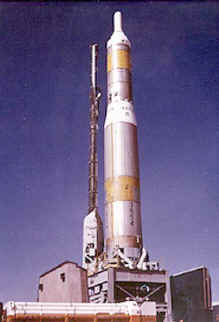| Preface
Ideology
Biology
Psychology
Sociology
Ecology
Cosmology |
 Finally, all of the
other realms are embedded within the vast extra-planetary environment -
i.e., the our solar system and galaxy and the larger Cosmology. Most of
this will seem to be remote from daily living; but, in fact, there are some
tangible considerations, and astronomical exploration certainly expands
the imagination and can be a source of wonder and even theological inspiration. Finally, all of the
other realms are embedded within the vast extra-planetary environment -
i.e., the our solar system and galaxy and the larger Cosmology. Most of
this will seem to be remote from daily living; but, in fact, there are some
tangible considerations, and astronomical exploration certainly expands
the imagination and can be a source of wonder and even theological inspiration.
The Skylab mission is developing methods for
living in space, and that will be important for monitoring and managing
the Earth's environment and resources and for using a zero gravity environment
for certain industrial processes. However, more critical is the prevention
of "asteroid and comet impact hazards".
In 1999, an amateur astronomer observed that
a meteorite had just passed the Earth in what was determined to have been
a near collision. While our vast, muti-billion dollar military and intelligence
surveillance agencies were busy paying close attention to every move of
our potential enemies and while our multi-million dollar astronomical groups
were occupied in discovering the outer edges of the expanding universe,
we were almost destroyed by a simple rock that had been careening toward
the planet for years. The ludicrousness of this situation does not have
to be emphasized.
 The surface of the
Moon is pocked with thousands of imprints of past meteorite impacts; and
in fact, the Moon itself is know to have been a chunk of our planet that
was torn off by the impact of an ancient asteroid that happened some 4 billion
years ago. On June 30, 1908, a comet exploded over Siberia in what is called
the Tunguska Event; and it is estimated to have been comparable to 100 Hiroshima-size
atomic bombs. In 1980, Louis and Walter Alvarez demonstrated that an asteroid
impact caused the mass extinction of species which occurred some 65 million
years ago, terminating the dinosaurs and the existence of over 90% of all
other species; and the crater of that asteroid was subsequently discovered
in Chicxulub, Mexico off of the Yucatan Peninsula. On July 16-22, 1994,
the world watched on television the Shoemaker-Levy Comet as it broke into
a cluster of over 20 fragments and exploded upon hitting Jupiter. Several
of those impacts were larger than the entire earth. The surface of the
Moon is pocked with thousands of imprints of past meteorite impacts; and
in fact, the Moon itself is know to have been a chunk of our planet that
was torn off by the impact of an ancient asteroid that happened some 4 billion
years ago. On June 30, 1908, a comet exploded over Siberia in what is called
the Tunguska Event; and it is estimated to have been comparable to 100 Hiroshima-size
atomic bombs. In 1980, Louis and Walter Alvarez demonstrated that an asteroid
impact caused the mass extinction of species which occurred some 65 million
years ago, terminating the dinosaurs and the existence of over 90% of all
other species; and the crater of that asteroid was subsequently discovered
in Chicxulub, Mexico off of the Yucatan Peninsula. On July 16-22, 1994,
the world watched on television the Shoemaker-Levy Comet as it broke into
a cluster of over 20 fragments and exploded upon hitting Jupiter. Several
of those impacts were larger than the entire earth.
On June 17, 2002, investigators at Lincoln Near Earth Asteroid Research
(a program at MIT and funded by the United States Air Force and NASA) discovered,
three days after the fact, that an asteroid had come within 75,000 miles
of the earth. Designated "2002 MN", with a velocity of about
6.2 miles per second and the size of a football field, if it had struck
the Earth, it would have been comparable to a large nuclear weapon with
a destruction zone of some 77 miles in diameter. The nearest miss was in
1994, when the asteroid "1994XL1" passed within 65,000 miles of
our planet.
Here are some statistics. As of April 2002
there are:
| Number of Asteroid Detections |
1,127,759 |
| Number of Confirmed Near Earth Orbits |
951 |
| Number of Confirmed Comets |
82 |
 For additional details
- see: NASA's Near-Earth Object
Program Office and Asteroid
and Comet Impact Hazards. And there are organizations that are attempting
to monitor the various objects - Space
Guard Foundation. For additional details
- see: NASA's Near-Earth Object
Program Office and Asteroid
and Comet Impact Hazards. And there are organizations that are attempting
to monitor the various objects - Space
Guard Foundation.
What is required is a well funded, dedicated
agency that maps the positions and trajectories of meteors, comets, and
asteroids and that has command of some of the arsenal of over 6,000 Inter-continental
Ballistic Missiles which can be used to redirect dangerous objects well
in advance of their proximity of Earth. This and other issues are the subject
of Chapter VI of the Manual.
Photo of Skylab, courtesy of NASA and the American taxpayer.
Depiction of asteroid impact {http://www.astro.uva.nl/encyclopedie/images/chicxulub.gif.}.
Titan -ICBM.
|